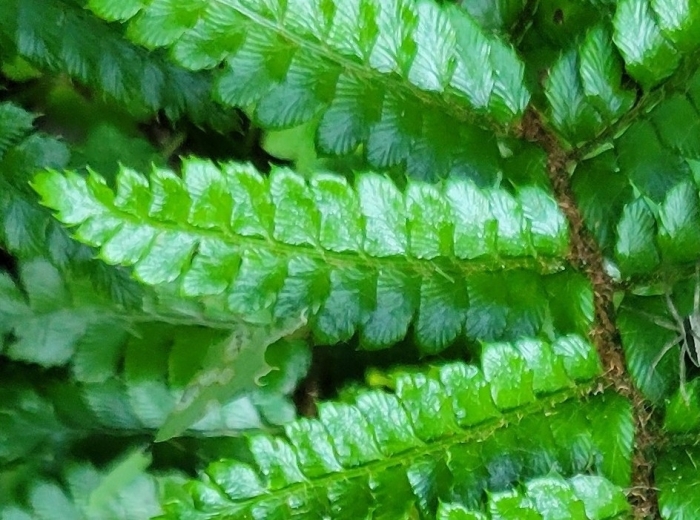Japanese Tassel Fern
(Polystichum polyblepharum)
Japanese Tassel Fern (Polystichum polyblepharum)
/
/

Gold eagle Kroll
CC BY 4.0
Image By:
Gold eagle Kroll
Recorded By:
Copyright:
CC BY 4.0
Copyright Notice:
Photo by: Gold eagle Kroll | License Type: CC BY 4.0 | License URL: http://creativecommons.org/licenses/by/4.0/ | Rights Holder: Gold eagle Kroll | Publisher: iNaturalist | Date Created: 2021-08-10T18:25:39-07:00 |







































































Estimated Native Range
Summary
Polystichum polyblepharum, commonly known as Japanese Tassel Fern or Korean Tassel Fern, is an evergreen fern native to the understory of moist, temperate forests in Japan and South Korea. It typically grows to 1 m (3.3 ft) tall and broad, forming dense, symmetrical clumps resembling shuttlecocks. The fronds are lance-shaped with finely serrated edges, contributing to its delicate, lacy appearance. The new fronds emerge upright and then arch gracefully as they mature, with a glossy texture that adds visual interest throughout the year.
The Japanese Tassel Fern is valued for its lush, evergreen foliage, which provides year-round interest in shaded garden areas. It is an excellent choice for woodland gardens, shaded borders, and as ground cover under larger plants. This fern is relatively low maintenance, requiring minimal care once established. It thrives in moist, well-drained soil rich in organic matter and prefers part shade to full shade. While it is generally disease-resistant, it can suffer from root rot if planted in overly wet conditions. It has earned the Royal Horticultural Society’s Award of Garden Merit, indicating its exceptional performance in gardens.CC BY-SA 4.0
The Japanese Tassel Fern is valued for its lush, evergreen foliage, which provides year-round interest in shaded garden areas. It is an excellent choice for woodland gardens, shaded borders, and as ground cover under larger plants. This fern is relatively low maintenance, requiring minimal care once established. It thrives in moist, well-drained soil rich in organic matter and prefers part shade to full shade. While it is generally disease-resistant, it can suffer from root rot if planted in overly wet conditions. It has earned the Royal Horticultural Society’s Award of Garden Merit, indicating its exceptional performance in gardens.CC BY-SA 4.0
Plant Description
- Plant Type: Fern
- Height: 1.5-2 feet
- Width: 1.5-2 feet
- Growth Rate: Slow
- Flower Color: N/A
- Flowering Season: Non-Flowering
- Leaf Retention: Evergreen
Growth Requirements
- Sun: Part Shade, Full Shade
- Water: Medium
- Drainage: Medium
Common Uses
Border Plant, Deer Resistant, Drought Tolerant, Groundcover, Low Maintenance, Potted Plant, Rabbit Resistant, Rock Garden, Street Planting
Natural Habitat
Understory of moist, temperate forests in Japan and South Korea
Other Names
Common Names: Japanese Lace Fern, 나도히초미, Inode
Scientific Names: , Polystichum polyblepharum, Polystichum japonicum, Polystichum aculeatum var. japonicum, Polystichum polyblepharum f. scabiosum, Polystichum polyblepharum var. scabiosum, Aspidium aculeatum var. japonicum, Aetopteron polyblepharon, Aspidium polyblepharon, Polystichum polyblepharum subsp. scabiosum,
GBIF Accepted Name: Polystichum polyblepharum (Roem. ex Kunze) C.Presl